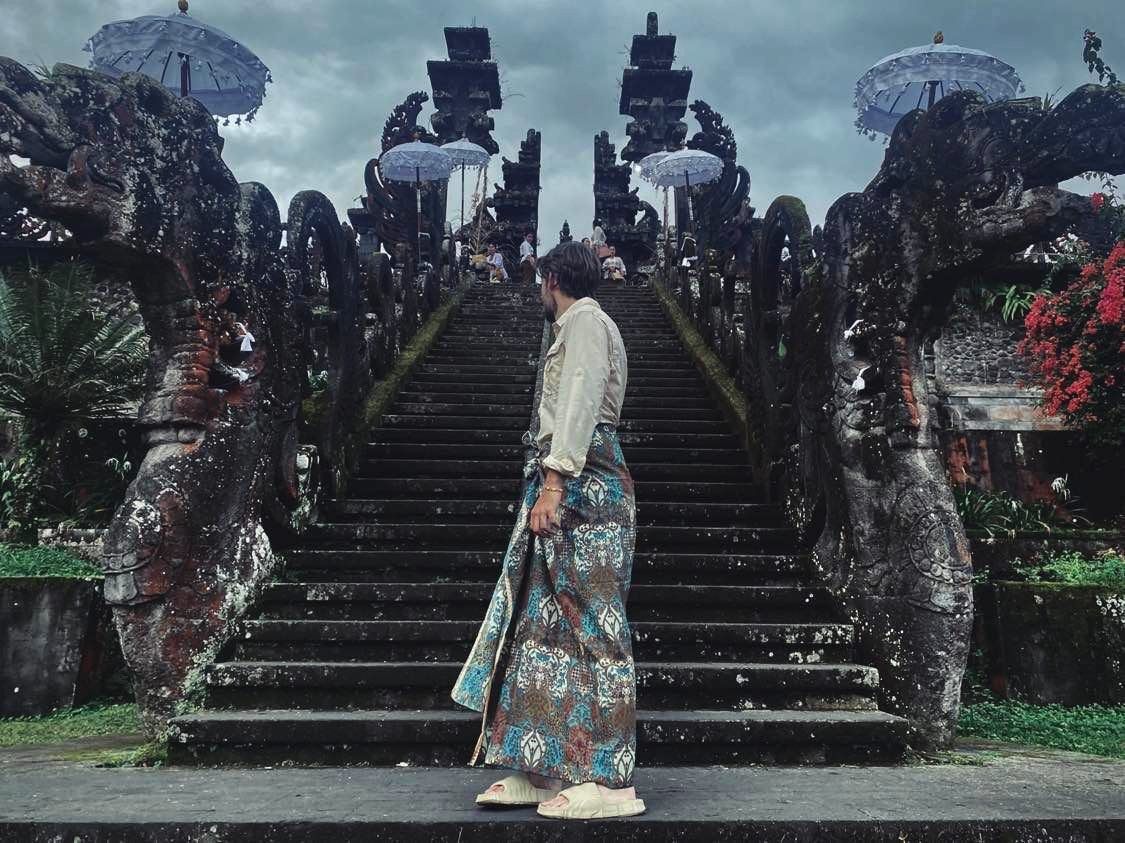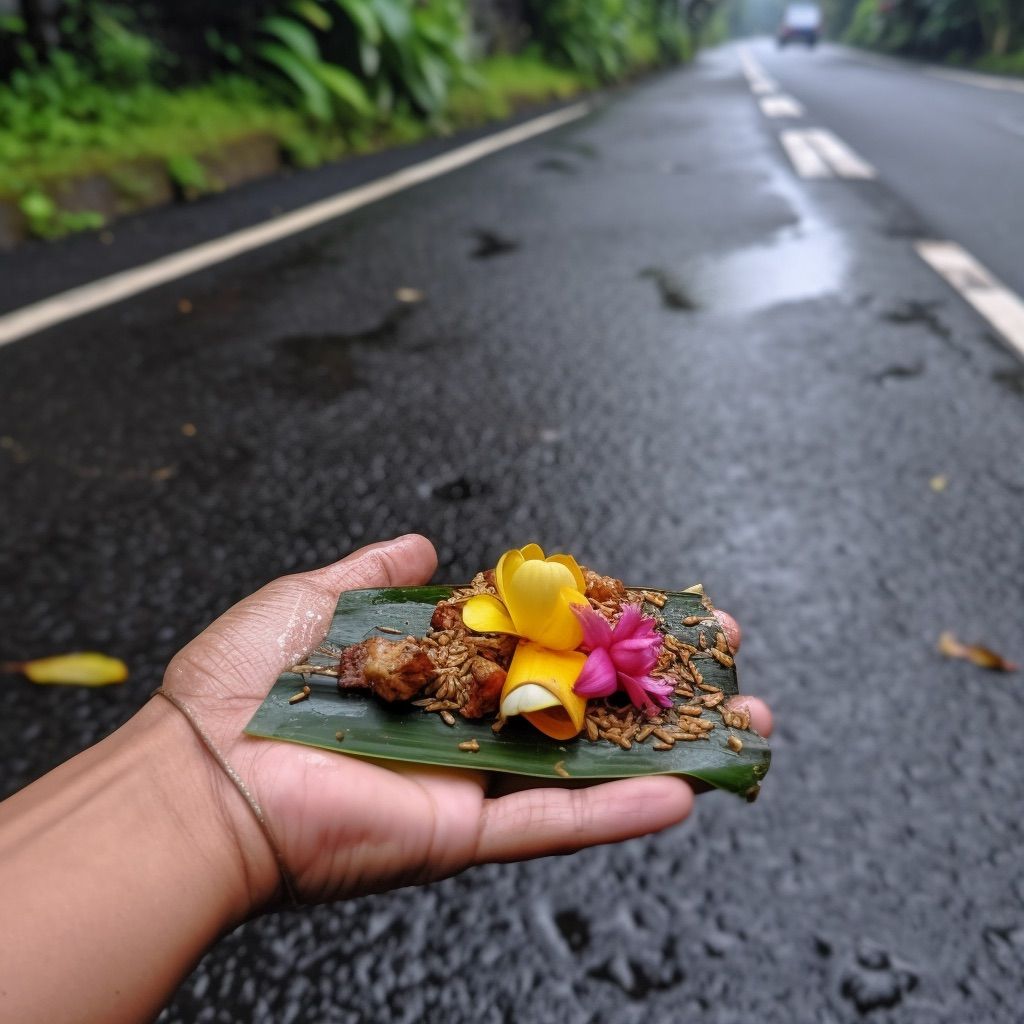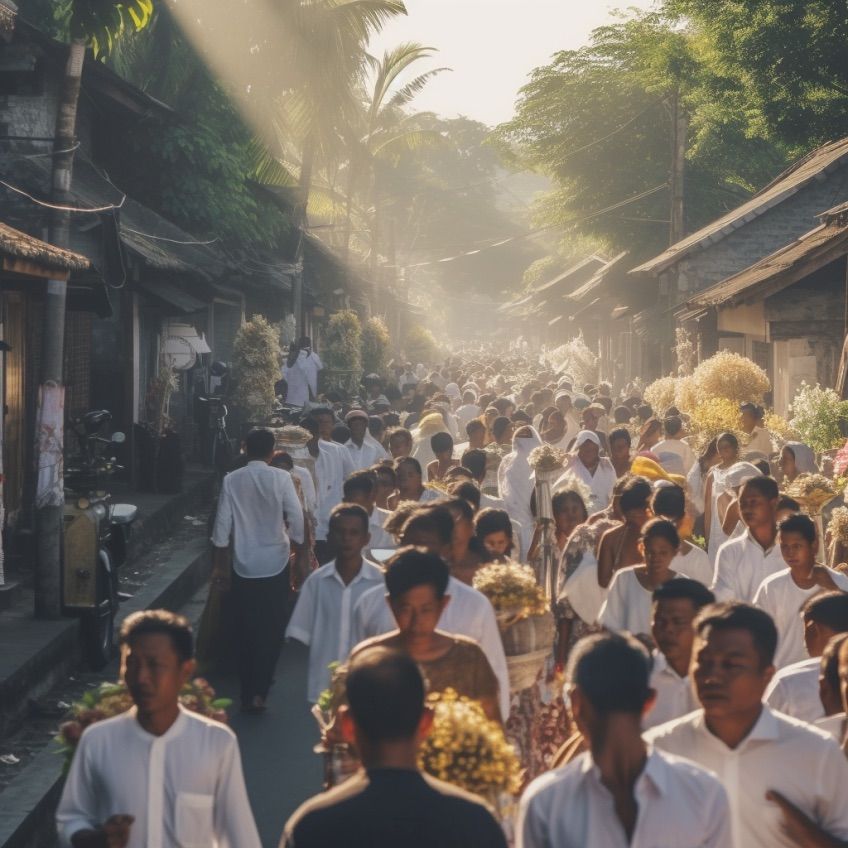
Beyond the beaches to the cultural heart of Bali
I sat, slumped and sodden in a firm chair on a narrow terrace in Undisan, Bali. Sheets of rain, total and unending, enveloped the adjoining courtyard. I wasn’t thinking about anything profound, just puzzling at my current condition, at once drenched and still sweating. Always sweating. I resembled less the intrepid adventurer of my aspirations, but instead, in my oversized blue poncho, a discarded bin bag.
Then three weeks into my travels around ‘The Island of the Gods’, I had left behind the villas, massages and piña coladas of an unforgettable and indulgent group holiday. I now found myself very much solitary, plastic-wrapped and perspiring.
Earlier that afternoon, I plodded up the imposing steps of the monumental Temple of Besakih, the spiritual heart of the island, sitting in the shadow of Mount Agung, Bali’s largest (and still active) volcano. But since removing my sari, donning the poncho, and carefully snaking down slippery jungle roads on my scooter in a downpour, I felt a little less awe-struck. It’s your classic case of a beholding-ancient-wonders-hangover.

I was interrupted from my state of moist, droopy, wallowing by approaching footsteps and a bright greeting.
“Halo!”
It was followed by the beaming smile and boyish giggle of Koman, the host of my homestay. He had commuted over an hour in the rain from Ubud, where he was a travel guide, cheerfully chaperoning busloads of French tourists through the region. He taught himself French online, he later told me, to carve out a niche apart from the oversaturated market of English-speaking Indonesian guides. He spoke in a curious flavour of Indo-French English. I felt, as I often do while travelling, a little embarrassed by my impoverished monolingualism. He was a man of humble stature in his 40s, though his buoyant personality made him seem younger. This youthful demeanour was offset by the occasional seriousness of French discernment.
Some clumsy introductions and several laughs later, over a glass of warm, amber tea, I asked Koman to help me better understand Bali. Beyond the tourist attractions and hospitable smiles, what was this island, and its people, really about?
Bali’s history is as rich and tangled as the island’s landscape. While there is evidence of human activity across Indonesia in palaeolithic times, Bali was likely one of the first Islands settled by Austronesian-speaking people from Taiwan and the Philippines around 3000 BC. According to expert archaeologist and historian, Wayan Ardika, these early migrants brought a "sophisticated knowledge of agriculture, metallurgy and ceramics, which they adapted to suit the ecological and cultural context of Bali.”
As someone who feels utterly lost in life without access to Google Maps, it’s hard for me to imagine these first foreign explorers, navigating and mastering this dense, wild place.

The cultural and religious character of Bali blossomed during the Hindu-Buddhist period (1st-15th Century), whose most visible legacy is the ornate temples that pepper the island, like Besakih, which I lumbered through that brooding afternoon as clouds gathered.
Indonesia has endured more than its fair share of the storms of history. Yet, throughout waves of turmoil - Islamic expansion, Dutch Colonialism and Japanese occupation - Bali has held onto its distinctive Hindu culture.
“There was a civilisation there”, my host, Koman patiently explained, gesturing towards the ‘Mother Temple’. But after being visited by a devastating plague, thereby finding themselves out of favour with the Gods, the people fled Bali for Java, then dominated by Islam. Centuries later, an honoured Hindu monk found “the answer” in meditation, Koman told me.
They could return to Bali, according to the story, only if they provided offerings to the Gods. The word ‘Bali’ comes from Sanskrit, meaning ‘offering’ and ritual generosity is woven into the lives of Balinese people. It spans from the grandiose to the commonplace. Bustling processions and countless festivals mark Bali’s traditional calendar while even a small act, like pouring the first drops of a newly-opened water bottle on the ground, is an offering to the earth.
I couldn’t help but notice offerings everywhere in Bali, I often swerved to avoid small, delicate compositions of flowers, spices and rice placed on the road in front of homes and businesses. I don’t consider myself superstitious, but running over an offering to the Gods in a hired scooter is asking for trouble.

Spiritual practices take many forms, Koman told me. “My wife comes from a neighbouring village and sometimes I have no idea what she’s doing!”
Some beliefs of Balinese people extend beyond the idiosyncratic, into the strange. Blended with their ceremonial and bejewelled Hinduism are more local animistic beliefs.
As the rain rattled on and the darkness deepened, Koman lent in with a playful smile.
“I cannot explain according to your logic, but we have these ‘black magic’ type of things.”
“Just this week,” Koman continued, "a ten-year-old boy went missing. All the locals in the village played traditional music in the streets, calling on spirits for help."
“We also called the police... you have to try both methods”.
The boy turned up two days later, Koman said, inexplicably sleeping next to a neighbour's barn.
“But you have to be careful!” he warned. Another local tale held that a man used dark arts to make a woman fall in love with him. The pair were married, but soon after the union, his new wife became mentally unwell and the man was plagued with guilt.
“But if all this black magic stuff worked, maybe we could have kicked out the Dutch sooner!” he said with a giggle.
I was inwardly surprised by the flippancy of this throwaway line, and yet I’ve encountered such mercurial attitudes in other Balinese people. Many hold deep and complex beliefs and yet take them with a grain of salt. They faced a tumultuous history and yet have emerged with dignity and, in the case of Koman, light-heartedness.
Koman explained the deep network of ties that held together his local village community.
“Everyone knows everyone. Everyone knows what you are doing. How you make money. And we all give back to the community to keep it going. It’s always like this.”
A traditional Balinese village is known as a ‘Desa Adat’, governed by a council of elders, who are the custodians of traditional culture and identity. Within villages, a ‘Banjar’ is a traditional neighbourhood association that maintains social order, resolves disputes and organizes local events and festivals. Anthropologists describe that these institutions “work together to ensure social harmony and community well-being.”
And yet, wherever there are people, there are problems.
“There are some people we don’t like in the village. Maybe they don’t invite us to their wedding.”
This, at least, is universal. Wedding invitations are complex political undertakings.
“But when someone dies, everyone in the village gathers,” Koman explained, sharing that he had an Aunty who passed away that morning, and many people would come to the temple later in the evening to pay their respects.
“We don’t share all the happiness but we always share the sorrow.”

I asked him about the influence of modern foreigners and whether the hordes of scantily clad, Bintang-wielding Westerners were eroding this community spirit.
“The modern life doesn’t take away from our spiritual life.” He stated plainly.
He paused for a moment and I realised the rain had stopped.
“You come here to see us,” Koman said, looking into my eyes with a smile, “but you will not change us.”
From the outside, Bali seems like a tapestry of living contradictions. Serene, pristine beaches alongside knotted, unforgiving jungle. An open and inclusive culture that holds mysterious, impenetrable depths. Modernising communities that remain proudly, persistently, traditional. A deluge of rain that can make you marvel. And make you sweat.
But from the inside, Bali's strong local communities and their welcoming people have much to teach the rest of us.
Visit, if you like, but bring an open mind. And a poncho.
Thanks to Koman for enlightening me and to his wonderful family for hosting me. You can stay with them at Rindu Homestay. Highly recommend!
References
Ardika, I. W. (1981). The Emergence of Balinese Civilization: A Historical and Archaeological Overview. In B. de Zoete & W. Spies (Eds.), Bali: The Imaginary Museum of Balinese Culture (pp. 24-51). Tuttle Publishing.
Lansing, J. S., & Fox, J. J. (2017). The social institutions of Bali revisited. In Foundations of Human Sociality: Economic Experiments and Ethnographic Evidence from Fifteen Small-Scale Societies (pp. 153-172). Oxford University Press.
Thanks for reading 😄
If you haven't already, you can sign up for my weekly newsletter, Mind Maps, for more on travel, culture and creativity.
